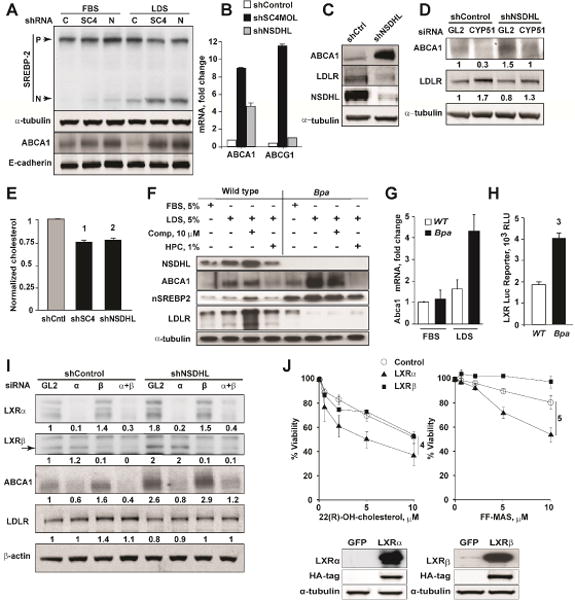Figure 4.

Deficiency of MAS metabolizing enzymes activates LXR targets in cancer cells. (A) Increased nuclear (N) fragments of SREBP2 and membrane-bound ABCA1 expression in SCC61 cells with shRNA-silenced SC4MOL (SC4) and NSDHL (N). (B) qRT-PCR measurement of LXR targets, ABCA1 and ABCG1, in SC4MOL-depleted A431 cells. Results represent mean±SEM from 2 independent RNA samples each analyzed in duplicates. (C) Expression of ABCA1 and loss of LDLR in NSDHL-silenced A431 cells by Western blot. (D) Silencing of an upstream enzyme, CYP51A1, with siRNA abrogates ABCA1 expression and rescues LDLR in NSDHL-deficient A431 cells (numbers, normalized bands density). (E) Reduced total cholesterol levels in SCC61 cells depleted of SC4MOL or NSDHL with shRNA. Data were normalized to total protein and shControl-depleted cells and represented as mean ± St.Dev of 3 independent experiments; (1) and (2), p=0.02 by Kruskal-Wallis test. (F) Pre-senescent mouse embryonic fibroblasts deficient in NSDHL (Bpa) show increased ABCA1 and loss of LDLR expression. This phenotype is exacerbated in cholesterol poor conditions which are used to accelerate the metabolic activity in the cholesterol pathway downstream of SREBP2 (LDS, lipid depleted serum; comp, compactin; HPC, hydroxypropyl-cyclodextrin). Increased mRNA of LXR targets, ABCA1 (G), and activity of LXR-luciferase reporter (H) in pre-senescent Bpa fibroblasts. Data are represented as mean±SEM, n=2 for (G), n=3 for (H); (3) p=0.03. (I) siRNA silencing of LXRα, but not LXRβ, abrogates ABCA1 expression in NSDHL-deficient A431 cells. (J) Lentiviral expression of LXRα but not LXRβ sensitizes SCC61 cells to FF-MAS and 22(R)-hydroxycholesterol. Shown, viability of SCC61 cells cultured in 1%LDS with indicated concentrations of sterols for 72 hours. Data are represented as mean±SEM from 4 experiments; (4) and (5), p=0.002. Insert, expression of LXRα and LXRβ as confirmed by Western blot.
